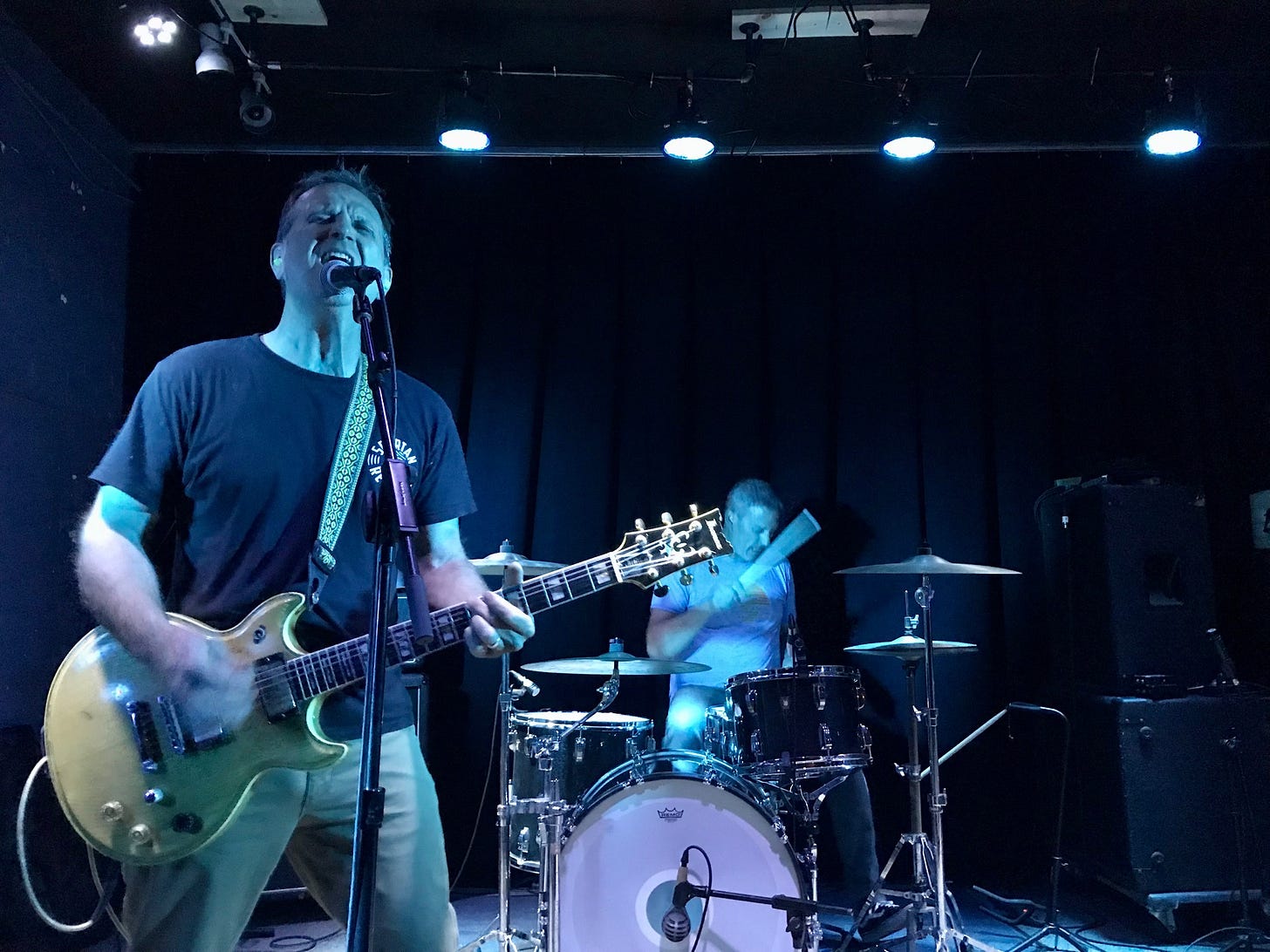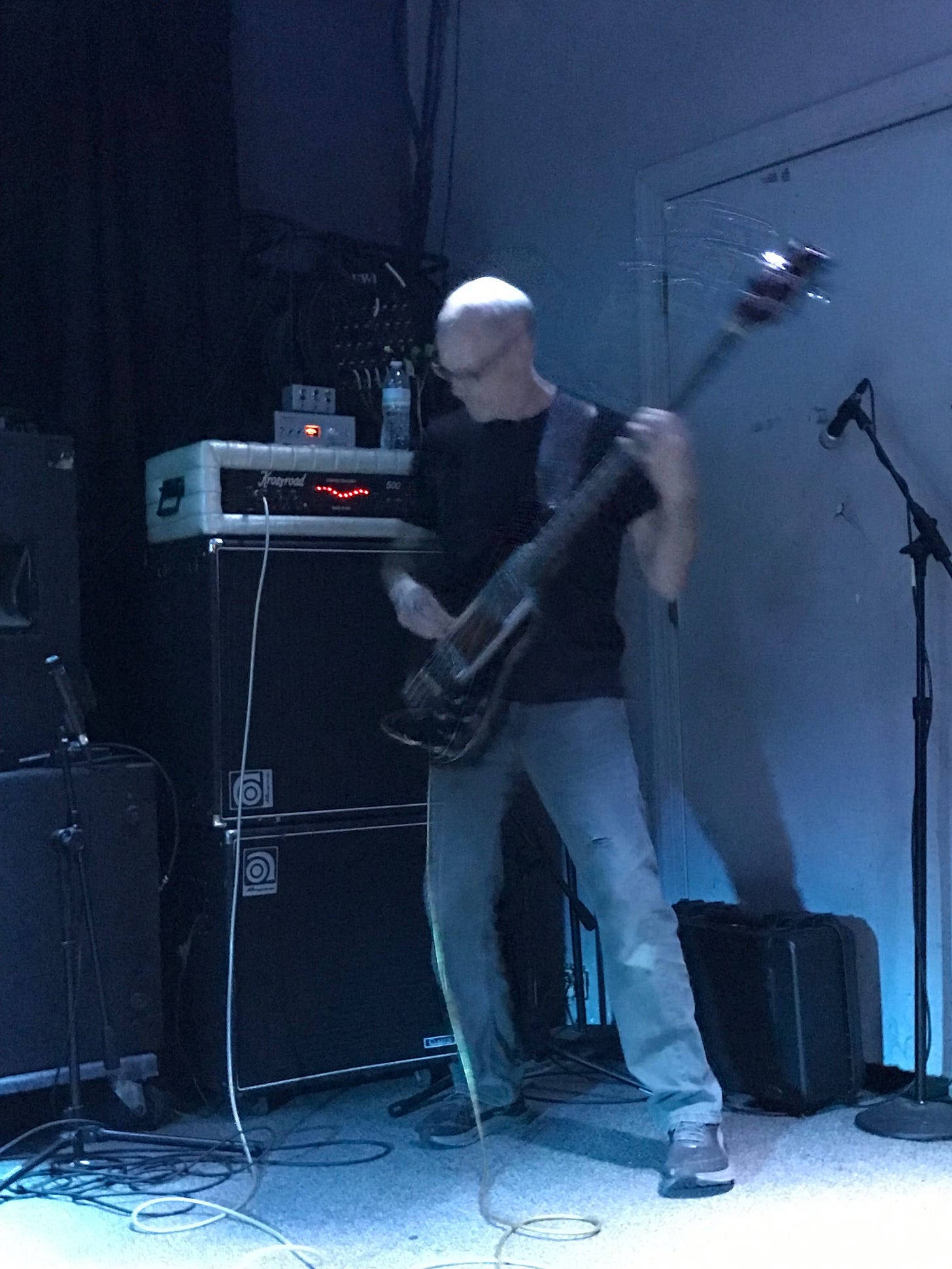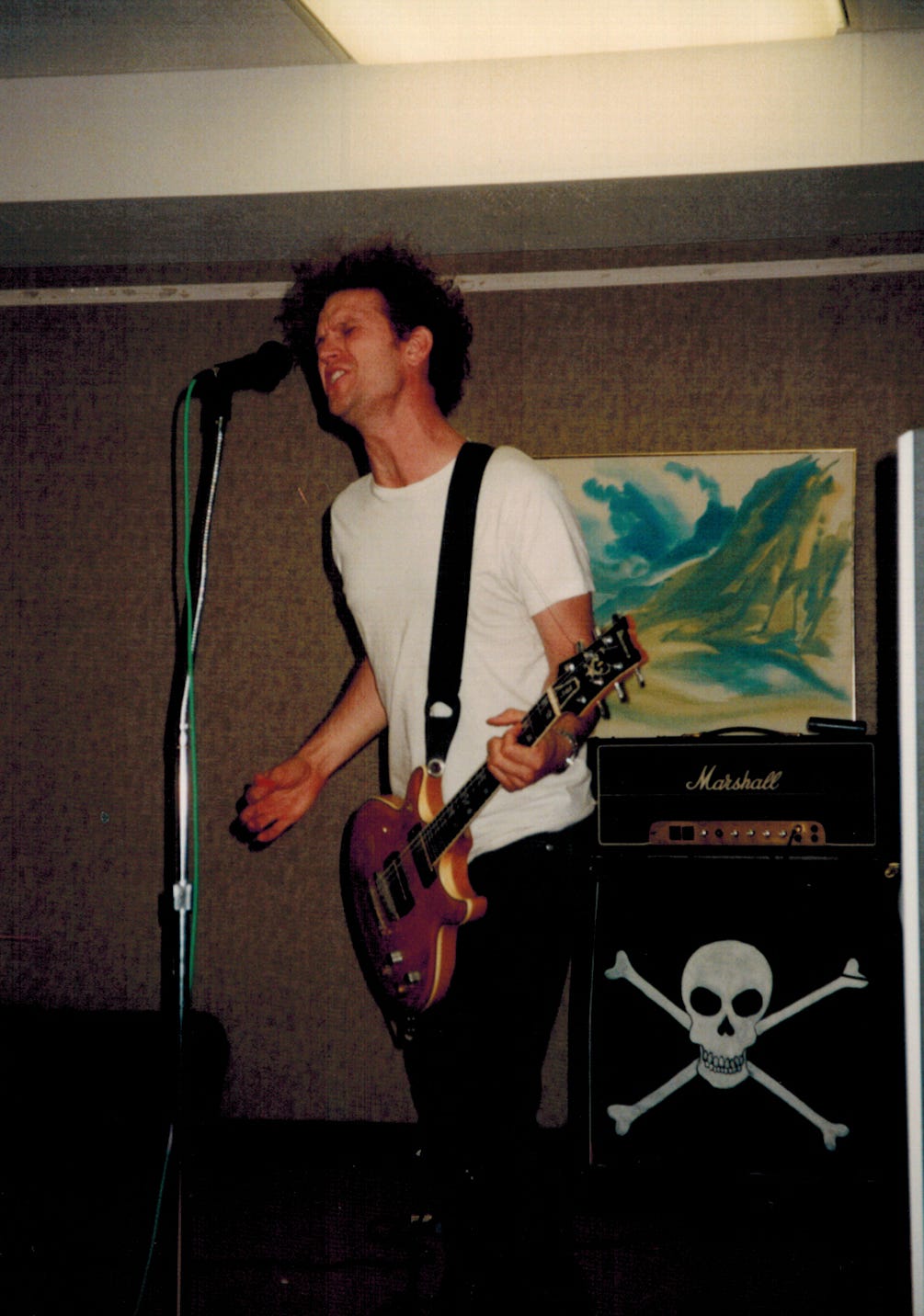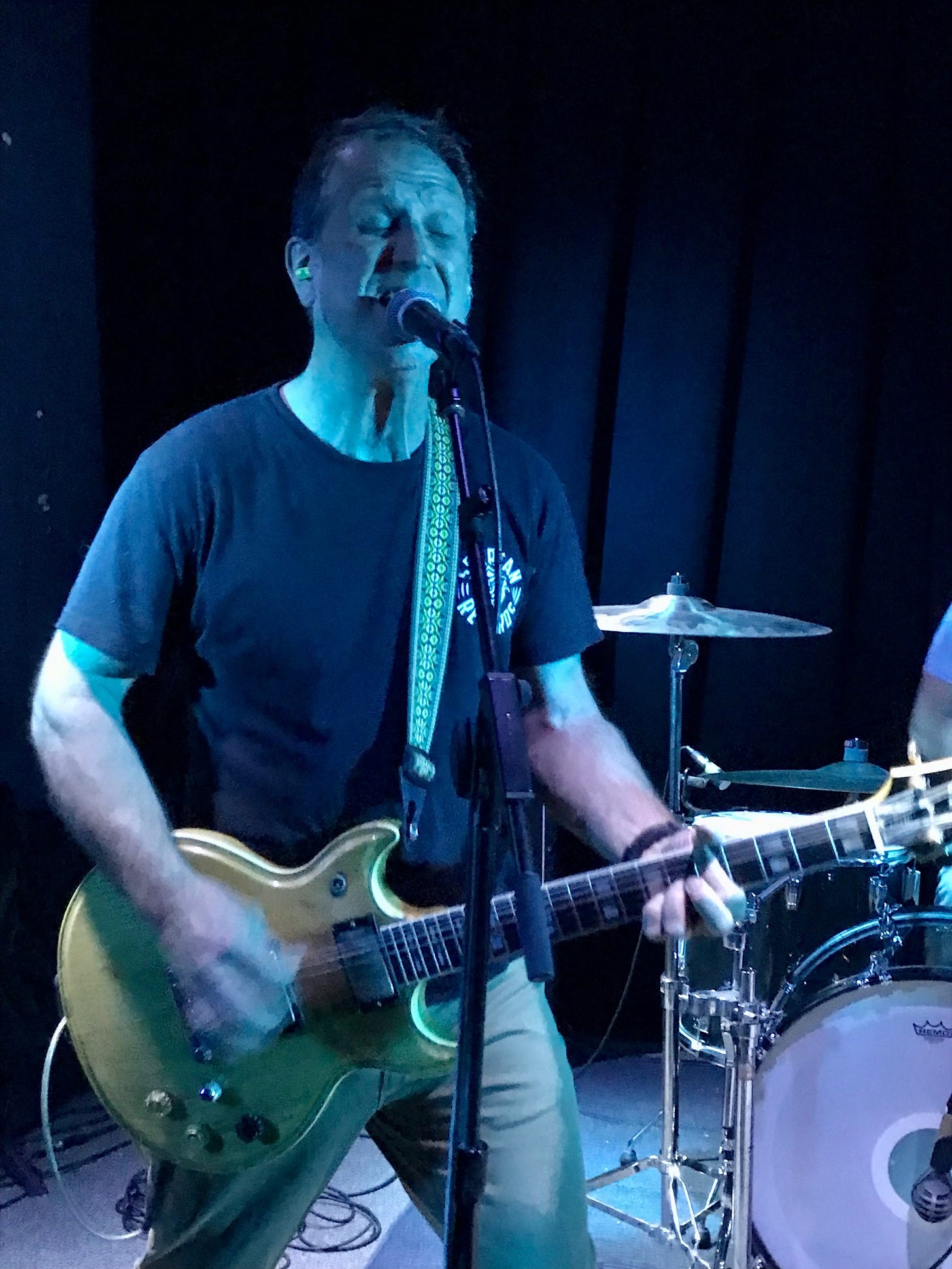Interview with Giants Chair
Seeing them live, and in conversation with, the Midwest legends nearly 30 years later.
I first heard Giants Chair probably in 1996. Some friends I was going to college with turned me on to them when their band did some shows with them around the East Coast. In my efforts to absorb whatever music others talked about I sought out Giants Chair and found their album “Red and Clear”, which proved to be this amazing mix of post-hardcore, Midwestern indie rock, and the dreaded ‘emo’ tag. There was something truly unique about their style that was all their own. Not too much later the band played my hometown of Syracuse in this little coffee shop. I was awestruck and fully on-board with the band.
Soon after they released their second LP, “Purity and Control”. They again played my region, this time at a small college show about an hour from me and this time I did a short interview with singer-guitarist Scott Hobart. It wasn’t great because I really wasn’t an adept interviewer at the time.
The band soon dissipated after this but their music continued to resonate with me, and have a huge impact on my tastes. The way they approached the art on their releases- simple, pragmatic, yet bold and direct through the use of letterpress and screenprinting, something I was wholly unfamiliar with at the time- eventually led me to explore the practice myself. I eventually got a tattoo of the “Purity and Control” braille from the record cover and am only one of two people I’m aware of with it. In the late aughts I started a band where one of the main influences was Giants Chair and we even covered one of their songs at our very first show. They have since entered indie lore and become a sort of band’s band with the likes of Shiner singing their praises and Cave-In recording a cover of one of their songs.
I always vowed that if they were ever to reunite I’d fly out to wherever they were to attend. Alas, that proved to be difficult because when it did happen, maybe 10 years after they split, the info got to me short notice and I couldn’t just hop a flight to Kansas City that quickly. It happened a few other times too. And I always missed it. But a couple months back when they announced a short Midwest run I got all impulsive and flew out to Chicago to see them play a small space, probably similar in size to places I saw them in the 90’s. And it was there I caught up with Scott Hobart after all these years and witnessed them play songs that I still love. They released a new album a few years back and it’s wonderful and they recently reissued “Red and Clear”, complete with the letterpress cover re-created by the same people who did it the first time. It’s truly beautiful. And this time around I had a much better conversation with Scott that kind of covers all the bases of this band whose music has brought me such happiness and inspiration.
How do you feel about your songs, performing them now, as opposed to when you were originally out touring and playing them back when you all were a more active band?
It’s been fun. You always hope that if you were playing something that long, or doing anything that long later on, that it would be timeless. Or that it would still interest you. Or you might hear some things about it that challenge you in some way, and all of those things work for me now playing these songs. Especially guitar-wise because I had fun writing them, and I have fun playing them now. I like those kinds of chords. Playing them back in the day I loved them then and we had fun playing them. And now they’re still there and I still like those sounds. Is that a good answer? That’s just the guitar stuff.
The lyrics are interesting. I like obtuse lyrics anyway. They mean things to me that maybe no one else would pick up on. It’s just an internal dialogue. Thankfully there’s vagueness in them. It’s not like I’m singing about some specific person by name from my past. In that sense it’s a bit timeless. So I think they’re holding up pretty good for me and my relationship to them.
Looking back on those lyrics I recall asking you about them a bit way back when we did a short interview in 1996. And when I asked back then about the song “New Orleans” you were a bit dodgy and just said, ‘it’s about a girl’. But there’s lines in that song that are incredibly powerful regardless of what meaning you draw from them and 30 years later do you feel a bit more comfortable talking about the meaning in some of those songs?
I think I do. And I think I am because at this point I’ve written a bunch of country songs. So I’m a bit more comfortable with being direct since country songs tend to be very direct, and very specific. They’re still vague in the sense that I don’t name names. And I’ve thought about the song “New Orleans” a lot and the generic answer is ‘it’s a blues song’. But it’s definitely about first heartbreak and feeling that it dehumanizes you in some way? You have to get callous and work through it, and you’re going to lose a part of yourself.
Those words, “first fist found is full-on, heavy just to teethe on”- you’re just a kid when these things happen to you.
It is interesting because you take a situation from that long ago and wonder, ‘do I still feel that way?’ Or do you grow up a bit? And mind you, I have several lyrical questions.
That’s fine. I appreciate that you’ve thought about them!
So a big song to me, because I have a tattoo of it, is “Purity and Control”, which by title alone could be taken as a very not good thing. But the way I always saw it, and I hope I’m right about this, is it had to do with having a focus, autonomy, and purity to your art and creativity. I felt it was about being authentic with your art and that’s what the song and album title had to do with.
Yeah, it was about a certain honesty and intensity, and living truthfully. I feel there’s things I’ve written in this context that I’m not sure exactly what it could be deciphered as that would be too specific. But there’s things that I would write that I just liked the image that would reverberate with the feeling of what I was trying to get across with some other lines in it. It seemed to make sense to me on some abstract level. I don’t know why it seemed to feel right, but it could be from the point of view of someone considering if ‘the system is a soul’, or ‘is a system devoid of a soul’ from the lyrics “we got a system, we got a soul, we got soul.” It may be a bit of a contradiction within the lyrics.
It’s a bit esoteric.
I will say too, that writing lyrics that are a bit obscure, or vague, I feel like sometimes I was just afraid to be very specific. I wanted it to be timeless. But I also wasn’t sure if I wanted say certain things.
It does give you a bit of free license to change the meaning later on if it doesn’t quite fit where you’re at 10-15 years later.
Or maybe it didn’t mean much at all and it just sounded cool. And then later you assign meaning.
Having done these on-off reunions over the years do you find that there are songs that just haven’t made it through the years, ones that you never play anymore?
There are some of those songs that we probably played a couple times live ever. So we hone in on songs that work well live and those become our list. We’ve tried to represent all three albums in our current set list. There’s not many that we haven’t played in a super long time that we decided to just break out. We sort of have our default ones from our first two records that we like and it’s also fun to have a more recent album that we can draw from.
Yeah, before I get into that the last lyrical question has to do with several of the songs from “Purity and Control” that have a thematical quality to them where some of the lyrics and ideas seem to carry across the record, from “The Speech” and “Blind In One Eye” both starting with the same lyrics, to the spoken word track with the story about the blind writer. So are these songs revolving around a fictional character?
You’re absolutely right, thank you for putting that together. I do remember whenever we were writing those songs I was getting more interested in a narrative and trying to tell a story, or make it sound like I was telling a story. Ultimately, I went further with that and that’s when I began writing country songs. I wanted to write a story. I was just trying to get the nerve to do that I think.
In a way I thought of “Purity and Control” as more of a concept album. I wanted the songs to relate to that story, “The Speech” and the blind writer.
I didn’t put that together, by the way, until a couple months ago. I’ve been listening to this record for nearly 30 years and it just started to occur to me.
I’m glad you picked up on it, finally. With the blind writer thing, I was thinking about the idea of blindness as sight, not being distracted. Having a clarity, or a desire for clarity.
Clarity in the face of adversity.
Yeah! And as you get older the world gets more complicated and you want to try and keep your vision, ya know?
So we talked about your feelings around the old songs. What’s your feeling around the new ones, because they definitely are more direct.
I kind of wanted them to have a sense of direction and narrative. But now after 20 years of writing country songs I wanted to experiment again with more abstract language and more contrasting images, or more romantic imagery. I feel like that album, “Prefabylon”, in parts has more road songs. Maybe it’s because I wanted to be on the road? I like the idea of things passing in the distance. Maybe it’s because I’m getting older, a little wistful. I love a lot of the songs on there, I’m proud of them.
I don’t think there can be a discussion about Giants Chair without the visual aspect. It always went really hand in hand. And I think when records like “Red and Clear” and “Purity and Control” came out that was an era where bands often did a lot of very DIY creative packaging with their records, from screened or hand-stamped covers, to insert booklets held together with twine, or whatever. But you all went a step further and worked with Hammer Press and made these letterpressed LP covers, which was really uncommon at the time. It certainly was an early inspiration for me to learn how to do that as well, but how did you all come across it?
Byron (Collum, bassist) and I met at the Art Institute in Kansas City and I had been in the painting and printmaking department for two years before I left to pursue music. Brady from Hammer Press was our roommate. He was at that school too, and he was in printmaking and letterpress. I know our LP “Red and Clear” was either the first, or one of the first full LP things that he packaged and printed. So we were just in the right place to work with him and it was a resource, and a friend, and he liked the band. We actually did a 7” too for the band that Byron and I were in before Giants Chair called Hollow Rain, which he printed the cover for as well. They’re out there somewhere.
So anyway, he was getting his thing together, we were getting our thing together, and we just collaborated on that. As far as the aesthetic for “Red and Clear” I was also working at a print shop at that time. It was an offset printing shop. The band got together in Green Bay, and then moved back to Kansas City, dragging Paul (Ackerman, drums) with us because there was more happening there. So I’m working at this print shop in Kansas City after we moved back and it was just me and this young dude working there. And I would ask him if it was cool if I printed posters for the band. He would just say, ‘yeah, I leave at 5 so do whatever you want after that’. So I started printing posters and developing a sense of that. So the concept for “Red and Clear” came from me printing poster stuff and then Brady at Hammer Press finalized the design.
Giants Chair, 1996, Herkimer, NY
I’m not sure if people reading this can grasp how time-intensive it is to do letterpress. Please tell me you didn’t do the whole lyric sheet that way as well?
No, the lyric sheet I did offset printing at the shop I worked at. But it was very labor intensive because we assembled all the covers too. I don’t know if it was a necessity thing where these were just the resources we had at hand, or was it just, ‘this looks so cool, let’s do it this way’, maybe a bit of both. Not to say letterpress is any cheaper than regular printing because it’s not. But there were bands at the time, stuff coming out of Chicago like Tortoise whose art and packaging for their records was very influential to us.
And with “Purity and Control”, not only did it have that really unique foldover sort of cover (on the LP) but having the raised braille across the whole cover (on the CD version) had to be incredibly difficult and labor-intensive to do.
I look at that record now and think, ‘it kind of works’. There was a bit of cracking in there but not enough to be a deal-breaker. But you’re right, it’s a lot of work. Brady is a great designer and a great thinker about these things. It was his idea to have it gatefold-open and then the perforated circle in the middle was cool. He’s great to work with. Anything we have approached him with he will take it and add something he’s been experimenting with so he keeps it very interesting for himself too. We are lucky we have been able to meet him. Plus he owed us rent. (laughs)
I get the sense you had the opportunity to mess around with that as well because I remember on one of your old tours you had a zine with you that looked maybe like letterpress (“Point Of no Return”). I think I still have it somewhere and it was about, what I’m guessing, your dad and him being a country music performer?
That was the original mythology of Rex Hobart, my country alter-ego.
But that was your dad’s name, if I’m not mistaken?
Yes. So the way that all works is that I started listening to some old country stuff when I would be on tour with Giants Chair. I was interested in writing stories and that is the music that I grew up with in my family. I was also very interested in having a stage character, basically it was like theater.
So I sort of wrote the back story to this through that zine. I mean, my dad was a real person. He was shot and killed in St. Louis when I was 14 and that’s kind of when I started playing guitar. I don’t think it was any kind of coping thing, I was just getting into music. So when I started playing country music I thought it would make it kind of tribute to his memory too. That was his style too. He didn’t play in a band or anything, he would just play around the house.
Did he write music?
He didn’t that I know of. He was a funny dude and I have fond memories of his sense of humor, his laughter and stuff. My folks had split up by then and he was living in Saint Louis. I grew up in southern Missouri in a little town. But he was still in our lives and would come visit. When he was killed he was just in the wrong place at the wrong time. But his name was Gerald Rex Hobart and that’s where the name comes from. He went by ‘Rex’ so for my country-legend persona I picked that name.
That’s an interesting story! I never knew the background of it, other than you performed under the same name as your dad.
And those were my first country song lyrics in that little zine. There was another zine for “The Speech”, which was all the lyrics for that. Or, I should say, it’s the story I recite on the album. Those covers were printed at Hammer Press too. The rest of that might have just been printed at a Kinkos or something.
So as far as reunion shows go you have been playing on and off for at least ten years now, but it’s just really sporadic. Maybe the reception is different in Kansas City, but compared to a lot of reunions that occur, even for bands that weren’t very well known, they get blown up into these huge things. However, all the reunion stuff you have always done has felt pretty low-key.
Yeah, it’s usually just if someone in Kansas City hits us up if our friends bands are coming through or something. We were never super popular either.
I think you were more of a band’s band.
That’s good enough for me, I like that too. I think our reunion shows have mostly been all bigger than actual touring shows we did when we were together. If you feel it’s worth getting back together than maybe it’s good enough for other people’s ears to have them come out.
There have been a number of bands recently that have done reunions where I never thought I’d see it happen. It just didn’t seem possible. And for the longest time I thought that about Giants Chair. I was resigned to having seen you a couple times in the 90’s and figured that was that. But now you’ve been doing shows on and off for quite a few years, sometimes years apart too. How did it originally come together to where you all decided t play together again?
That’s a good question because we never really said ‘it’s over’. There was never any acrimony. I remember we had just finished the “Purity and Control” tour and I was sitting with Paul on the front steps of the apartment building my wife and I were living in, and we were just talking about what our next moves would be. And we came to this thought that stuff we were starting to write just didn’t feel all that great, and it just wasn’t happening. We just didn’t feel it. And I didn’t want to try to write something if the feeling wasn’t there. And I was already starting to write country stuff too.
So we just kind of let it go, but it was never a hard stop. I think the first reunion or two was just bands in Kansas City that were contemporaries of ours saying they were playing some thing and asked if we would play and we thought, ‘sure, why not’. It wasn’t so much that we quit, it’s just the frequency got minimal.
It’s been fine though. I don’t think any of my bands have ever said, ‘that’s it’.
So that shift from writing Giants Chair songs, to writing country songs for so long, and then shifting back to writing new Giants Chair songs, was it a bit of a learning curve to get back into it?
That was a bit of an interesting journey. We had originally just planned to remaster, or re-record some old stuff. But then we just said, ‘let’s write a new album’. That’s where “Prefabylon” came from. I was still playing weird electric guitar stuff while playing country stuff. I work in theater and we were doing this weird theater show where I was playing underscore for these Halloween shows like “Night Of the Living Dead” and Edgar Allen Poe stuff. So I would just be the underscore noodler in these weird productions. I love that stuff and it’s a lot of fun. So through the experience of doing a few of those productions I had some ideas on the fretboard that I thought were pretty cool. So I had some musical ideas, but the lyrics were tough because going from writing straight-up country songs to getting back to more abstract structures and language was challenging. It took some time. To tap back into the way I’d write back then was a lot of word collage, or just stream of consciousness. I’d be thinking about something, but see what seemed salient. Whereas in country songs you get one sentence where you want someone to say this to somebody, how do I set that up? That’s my approach.
To go back into that thing after having all this narrative stuff it was certainly a challenge. And as far as playing with Byron and Paul we don’t talk about the music much when we’re playing it, but I’ll have a part and we don’t talk about the song structures all that much. It’s more like, ‘that felt good, let’s do that again’. It was very organic and I think that has helped us just jump right back in. We don’t have any hard system that we try to adhere to. And they’ll play whatever I write. (laughs). I think there’s been a total of maybe two times where collectively they weren’t into what I was coming up with.
Scott Hobart and yours truly in Chicago, showing off my “Purity and Control” tattoo









I had never even heard of this band before reading this. I’ve now listened to every album several times. Thanks for the introduction!